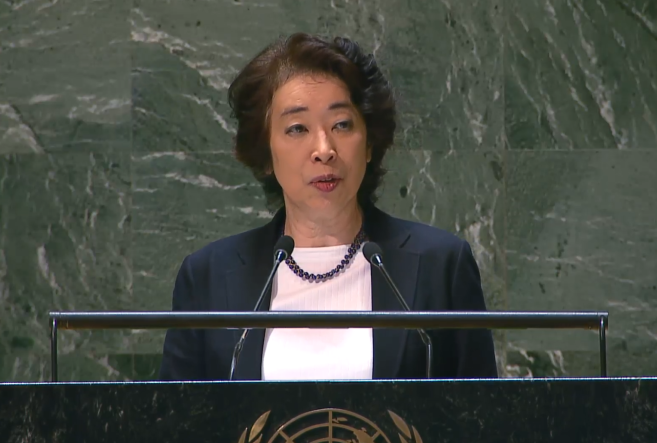平和構築委員会(PBC)報告書、平和構築と平和の持続及び平和構築基金(PBF)事務総長報告書に関する国連総会合同討論における志野大使ステートメント
令和6年7月16日

(As delivered)
Thank you, Mr. President.
Thank you for convening this meeting. I also wish to express my appreciation to the Chair and Vice-chairs of the Peacebuilding Commission (PBC) and the Peacebuilding Support Office (PBSO) for facilitating the work on peacebuilding.
The root causes of conflict depend on the context of each situation, and there are no one-size-fits-all solutions. But still, there will be some lessons we can learn from and ideas that we can share. The root causes are often intertwined and should be resolved comprehensively, ensuring the Humanitarian, Development, and Peace (HDP) nexus. The UN’s Peacebuilding Architecture should support such efforts coherently, by leveraging the uniqueness of the PBC and the PBF including their convening, bridging and catalytic role.
To begin with, I would like to discuss a few points about the PBC.
First, we should seek to address challenges across a wider geographic scope. Many challenges are transnational and transborder, such as the fight against terrorism, combatting the illicit trade of weapons and drugs, water scarcity, migration and others. Any Member State, and any region, can utilize the PBC’s convening power to gain political and financial support from the UN system and beyond, including from IFIs, national donors and possible South-South and triangular cooperation. Regional and cross-border meetings can also be enhanced, such as the Sahel meeting on transnational organized crime, terrorism, and violent extremism. I encourage my colleagues here to further engage with countries and regions which could benefit from the opportunities provided by the PBC, by highlighting the effectiveness of this platform.
Thank you for convening this meeting. I also wish to express my appreciation to the Chair and Vice-chairs of the Peacebuilding Commission (PBC) and the Peacebuilding Support Office (PBSO) for facilitating the work on peacebuilding.
The root causes of conflict depend on the context of each situation, and there are no one-size-fits-all solutions. But still, there will be some lessons we can learn from and ideas that we can share. The root causes are often intertwined and should be resolved comprehensively, ensuring the Humanitarian, Development, and Peace (HDP) nexus. The UN’s Peacebuilding Architecture should support such efforts coherently, by leveraging the uniqueness of the PBC and the PBF including their convening, bridging and catalytic role.
To begin with, I would like to discuss a few points about the PBC.
First, we should seek to address challenges across a wider geographic scope. Many challenges are transnational and transborder, such as the fight against terrorism, combatting the illicit trade of weapons and drugs, water scarcity, migration and others. Any Member State, and any region, can utilize the PBC’s convening power to gain political and financial support from the UN system and beyond, including from IFIs, national donors and possible South-South and triangular cooperation. Regional and cross-border meetings can also be enhanced, such as the Sahel meeting on transnational organized crime, terrorism, and violent extremism. I encourage my colleagues here to further engage with countries and regions which could benefit from the opportunities provided by the PBC, by highlighting the effectiveness of this platform.
Secondly, we welcome continued thematic engagements such as on YPS, WPS, the role of education, transitional justice, climate-related challenges, and national prevention. Japan hopes to see more good examples of prevention and early warning presented and discussed at PBC meetings. Additionally, on thematic meetings, the PBC can invite a wider range of stakeholders within and outside the UN system, to share their knowledge and best practices.
Thirdly, we would like to call for enhanced engagement between the General Assembly and the PBC on peacebuilding-related matters. We should also strengthen the utility and timing of the PBC's advisory role to the Security Council. As an informal coordinator between the Security Council and the PBC, we would like to call on Council presidencies to request PBC advice at the earliest-possible timing and PBC members to constructively discuss and reach consensus in a timely manner. Also, each Council member should consider incorporating the advice into its position as well as Council outcomes. General Assembly is the place of international public eyes, whether Council is utilizing the PBC advice properly.
Mr. President,
Please allow me to continue with the PBF, where we contributed over fourteen (14) million USD from 2020 to 2024.
First, the PBF’s comparative advantages over other funds are its agility and flexibly in responding to peacebuilding needs on the ground. These characteristics are indispensable for delivering its projects and must be maintained.
Second, we should further pursue strengthening the catalytic role of the PBF as “seed funding”. In this vein, the PBSO needs to identify projects that have been particularly successful and require further investment, and appropriately visualize and publicize them to catalyze additional projects by Agencies, Funds and Programmes, IFIs, bilateral donors, and more. To this end, I suggest utilizing the Impact Hub, as well as the General Assembly and the PBC, especially to enhance visibility. Inviting potential donors to PBF donor visits could be another idea.
Third, we must strengthen the system-wide coherence of all the UN’s relevant activities conducted by different entities, including peace operations and Agencies, Funds and Programmes. The synergy of all these activities will be maximized when they are coordinated and share a greater common goal. The HDP nexus approach should be strengthened not only on the ground but also at the Headquarters level.
In conclusion, I would like to reaffirm Japan’s full commitment to advancing conflict prevention and sustaining peace, including at the upcoming 2025 Peacebuilding Architecture review.
I thank you, Mr. President.
